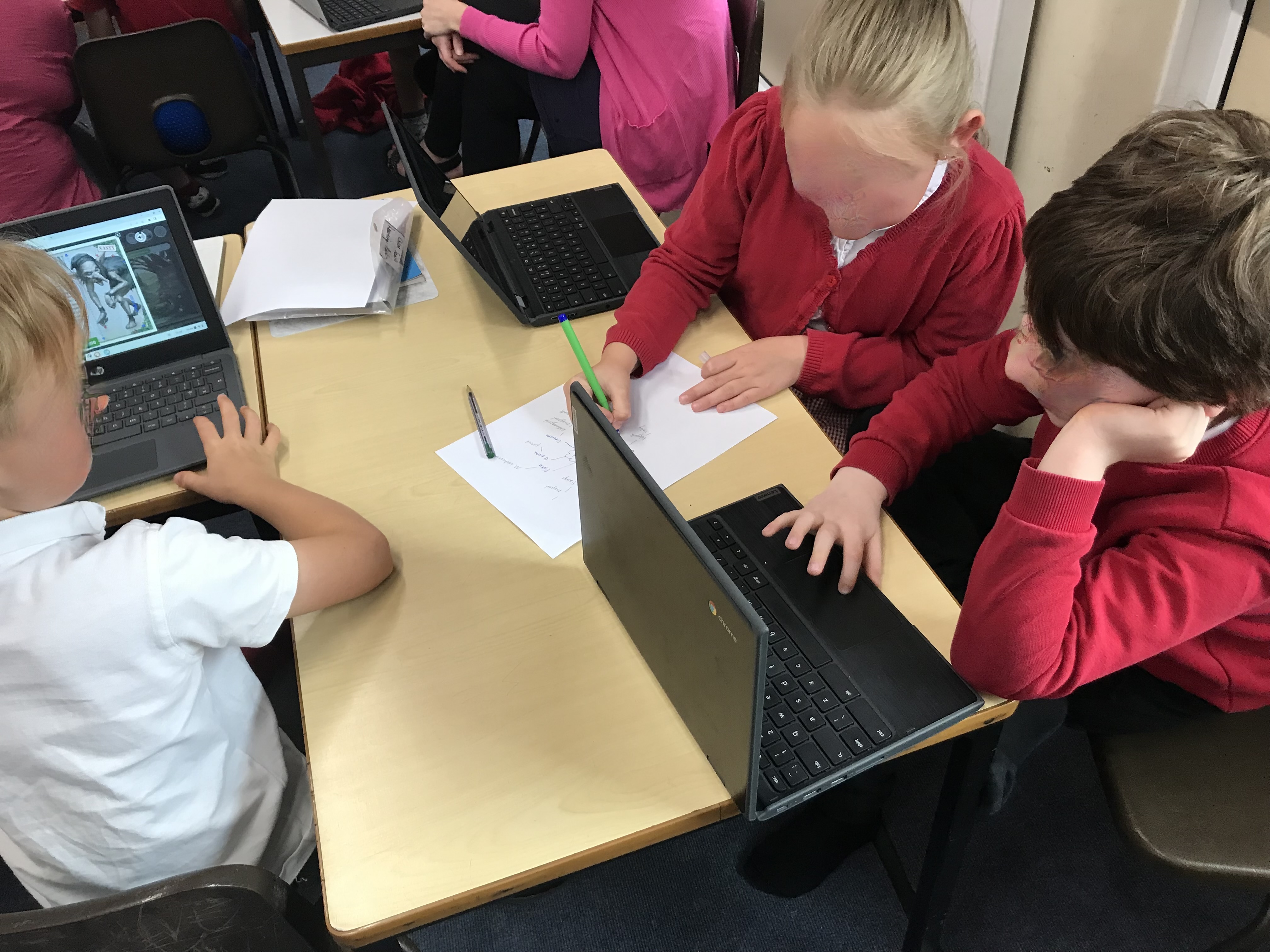Lesson Commentary
Review of prior learning – grammar, peer feedback and editing
The teacher reminds children of the previous lesson’s objective: to use knowledge of expanded noun phrases to describe he bewitched forest effectively. Using the IWB, she displays a colour coded text to illustrate expanded noun phrases. She asks children to share examples of effective descriptions (from yesterday). The teacher reminds children that good writers read back and improve writing. She asks children to look for errors in punctuation, and explains that their writing needs to make sense. Children read their own writing and then partner swap to look for what to improve. There is a use of multiple resources happening: the dictionary on lap/ Chromebook on desk/ writing text on paper alongside.
Teacher models how to find and read information using the interactive scene to make a mini mind map
The teacher introduces the new activity: to decide which character will be most helpful on the mission to find the lost children. She shares the lesson’s objective using the IWB: Justify our choices for choosing one creature to help our character find Jakob and Maria. A full set of images of possible characters are displayed on the working wall. The teacher models how to use the interactive scene to find information about each character (by clicking on the exclamation mark boxes). The teacher models how to make a mini-mind map for each character on the flipchart. The teacher explains the activity and its purpose. Children are fidgeting and a little distracted.
The children read information about the different creatures (from pop-out boxes in the interactive resource)
Children begin the activity. It is noisy, but very quickly, the children focus closely on the interactive scene and exploring what each character’s qualities are (by reading the information pop out boxes, and adding information to their mind-maps). The children are talking while staring at their own screens. They move their focus from their screen to their partner’s, with ease. The IWB plays the interactive scene too, providing a soundscape, for the activity. The teacher circulates, chatting to the children about their ideas and what they are reading. The vocabulary in the pop-out text boxes is challenging.
Children making mini mind-maps

The children create mini mind maps about each creature on a printed image of each character
Children record adjectives or noun phrases to describe each character on an image of it (making a mini mind map). Some children independently work out that the resource provides additional information (about why the creature is a good choice), by selecting from an option. Children work out that they can press the audio button to listen to the text. Other children work out that there is a ‘choose’ button – that gives the information the teacher wants. They then add this to their mind map.
Teacher models how to justify choosing a character
Teacher asks children to close Chromebook. They continue making notes. The teacher stands at the IWB and explains the next task: to justify choosing one creature. She displays a model sentence start and asks children to tell her back what they have to do, but they can’t. She redirects their attention to her model and is firm about what they have to do. Children can’t repeat the instructions – so the teacher repeats them, and emphasises the need to listen to procedures.
Children write justifications using sentence starters (writing frame)
The children write their justifications: “We have chosen the fawn because…” on scraps of paper, using sentence openers from the IWB. This involves assimilating ideas from their mind-maps and translating their ideas from one format to another. The children become focussed and complete the task.
The teacher restates expectations for presentation: capital letters and full stops, while the children work. She addresses the children – but they do not look up from their work. Children add annotated images to the learning wall.
Children read work aloud for feedback
Children are asked to read their writing aloud. The teacher gives feedback, noting use of noun phrases and strong justifications. Most pairs have chosen the same creature, and written the same justification. The children add their mini mind maps to the working wall.
Teacher uses working wall to review each character’s attributes
The teacher uses the images presented on the working wall to work through each character and identify who might be the best at helping the rescuer. Each child contributes ideas and listens to each other. This is channelled through the teacher. The teacher builds dialogue to develop children’s thinking. Children are looking at the working wall, the IWB, and their writing.
Observations about enjoyment and engagement
Children enjoy interrogating the interactive scene. There is high excitement and energy. Children are making meaning and engaging with the interactive scene, actively. They engage across multiple resources at the same time. The switch from interacting with the digital world, to the more formal writing task is challenging. The teacher has to work hard to build engagement in the formal writing task. The children engage actively (completing the task) and appear to enjoy writing their justifications, once they are settled into the familiar routine.
